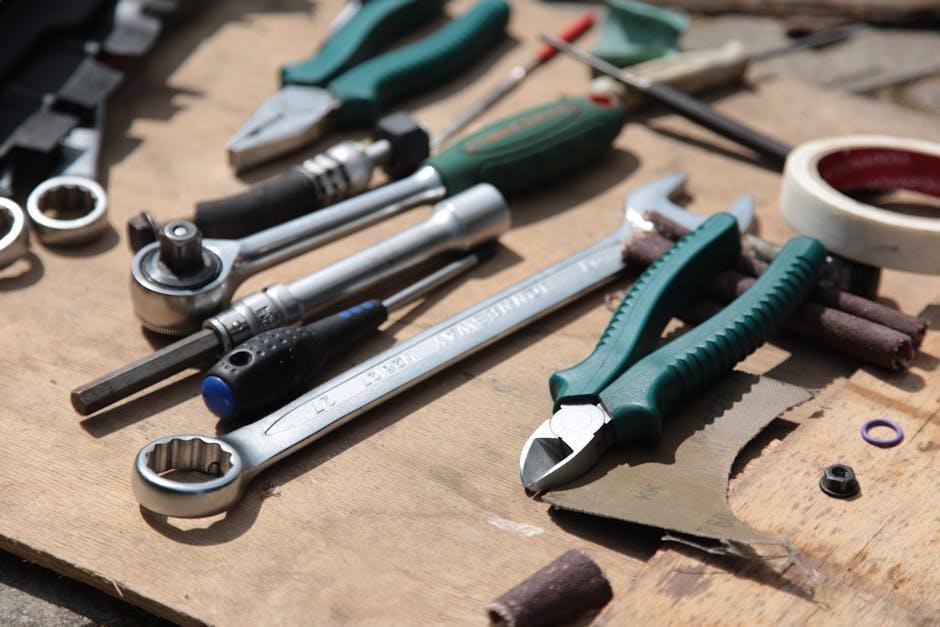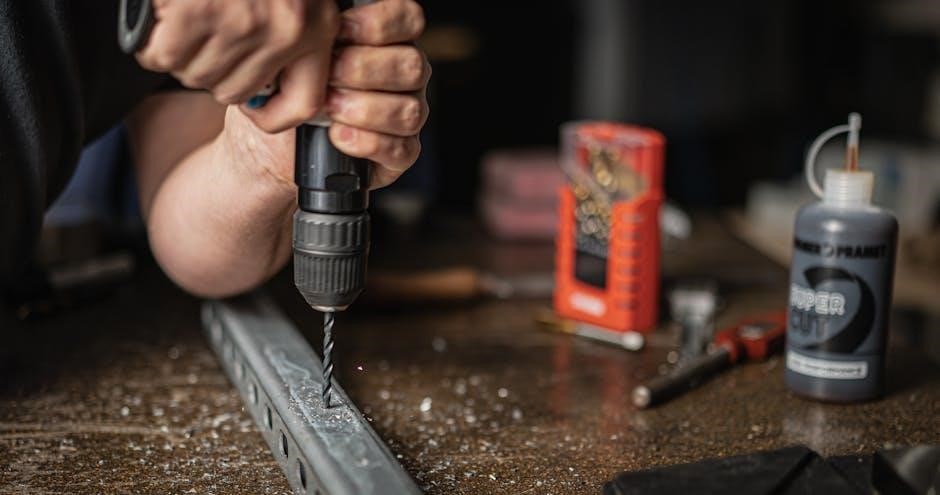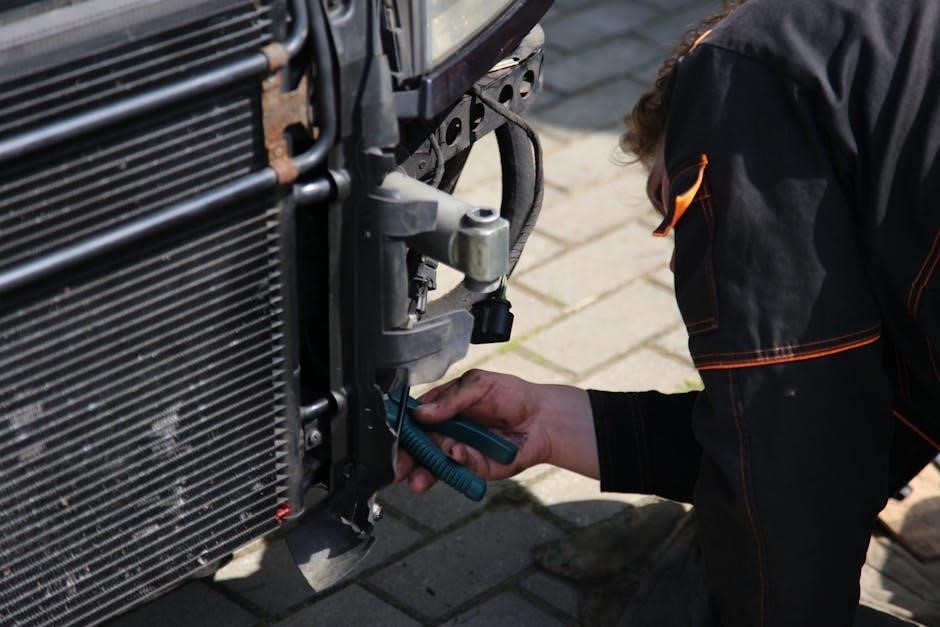Welcome to the Tru-Bolt Electronic Lock manual, your comprehensive guide to installing, programming, and troubleshooting your lock․ This manual ensures seamless operation and optimal security for your home․
Overview of the Tru-Bolt Electronic Lock
The Tru-Bolt Electronic Lock is a cutting-edge, keyless deadbolt designed for convenience and security․ It features a programmable keypad, allowing users to create unique access codes for family, guests, or service providers․ The lock is compatible with both left- and right-handed doors and offers an adjustable backset latch (2-3/8″ or 2-3/4″) for easy installation․ With a key override and interior turn piece, it provides manual operation when needed․ The battery-operated keypad illuminates and beeps for easy use in low-light conditions․ Tru-Bolt locks are known for their durability, affordability, and stylish designs, making them a versatile solution for home security․ They are backed by a Limited Lifetime Warranty, ensuring long-lasting performance and peace of mind for homeowners․
Importance of Following the Manual
Following the Tru-Bolt manual is essential for ensuring proper installation, programming, and operation of your electronic lock․ The manual provides step-by-step instructions to help you avoid common mistakes and potential damage to the lock․ It also includes troubleshooting tips to resolve issues quickly, saving time and frustration․ By adhering to the manual, you can ensure optimal performance, security, and longevity of your Tru-Bolt lock․ Additionally, understanding the manual’s guidelines helps you make the most of advanced features like biometric touchscreens or smart home integration․ Proper use of the manual also ensures compliance with the product’s warranty terms, providing peace of mind for your investment․ Always refer to the manual for clear, detailed guidance tailored to your specific Tru-Bolt model․

Installation of Tru-Bolt Electronic Deadbolt
Tools and Materials Needed
A drill, screwdriver, router, and measuring tools are essential for installation․ Additional materials include screws, a strike plate, and the deadbolt latch for secure fitting․
To install the Tru-Bolt Electronic Deadbolt, you will need a drill, screwdriver, router, and measuring tools․ Additional materials include screws, a strike plate, and the deadbolt latch․ Ensure all components from the packaging are included․ A pencil or marker is handy for marking drill holes․ For precise alignment, use a level to ensure proper installation․ Refer to the manual for specific requirements, as some models may need additional tools․ Gather all items before starting to streamline the process․ Proper preparation ensures a secure and functional installation․
Preparing the Door and Door Frame
Before installing the Tru-Bolt Electronic Deadbolt, ensure your door and frame are properly prepared․ Measure the door thickness to confirm compatibility, typically between 1-3/8″ and 1-3/4″․ Mark the center of the door edge for the deadbolt latch, aligning it with the existing lock․ Check the door’s backset to ensure it matches the latch’s adjustable 2-3/8″ or 2-3/4″ configuration․ Clean and inspect the door frame, ensuring it is free from debris and damage․ Verify the strike plate alignment with the latch to guarantee smooth operation․ A proper fit is crucial for security and functionality․ Use a pencil to mark drill holes for accurate placement․
Step-by-Step Installation Process
Install the Tru-Bolt Electronic Deadbolt by starting with the latch assembly․ Attach the deadbolt latch to the door edge, ensuring the UP marking faces upward․ Drill pilot holes for the strike plate on the door frame, aligning it with the latch․ Secure the strike plate with screws․ Next, attach the exterior keypad faceplate to the door, connecting the wiring to the latch assembly․ Install the interior faceplate, ensuring proper alignment and wiring connections․ Tighten all screws firmly․ Finally, test the lock by entering a user code to ensure the deadbolt extends and retracts smoothly․ Refer to the manual for wiring diagrams and specific model instructions to complete the installation successfully․

Programming Your Tru-Bolt Electronic Lock
Programming your Tru-Bolt Electronic Lock involves setting a master code, adding user codes, and managing access․ Use the keypad to enter codes, troubleshoot issues, and ensure secure operation․
Understanding the Programming Code
The programming code is essential for configuring your Tru-Bolt Electronic Lock․ It allows you to set or reset user codes, manage access, and customize lock settings․ The default code is provided in the manual or on the manufacturer’s website․ To use it, enter the code on the keypad, followed by the desired function․ Changing the programming code is recommended for enhanced security․ If issues arise, such as low battery or incorrect code entry, refer to the manual for troubleshooting steps․ Always keep the programming code secure to prevent unauthorized access․ If you encounter persistent problems, contact Tru-Bolt customer support for assistance․ Proper use of the programming code ensures your lock operates effectively and securely․
Adding and Managing User Codes
Adding and managing user codes on your Tru-Bolt Electronic Lock is a straightforward process that enhances security and convenience․ Start by entering the programming code, typically found in the manual, to access the user management menu․ From there, you can create unique codes for family, guests, or service providers․ Temporary codes are ideal for granting limited access, while permanent codes offer ongoing entry for trusted individuals․ To remove users, revisit the menu, select the code to delete, and follow the prompts․ Regularly updating codes ensures security․ Keep codes confidential and consider tracking access for monitoring․ If issues arise, refer to the manual or contact support for assistance․ This feature allows you to customize access efficiently while maintaining your home’s security․
Troubleshooting Programming Issues
If you encounter programming issues with your Tru-Bolt lock, start by verifying the programming code is correct and entered properly․ Ensure the lock is in programming mode and batteries are fresh, as low power can disrupt functionality․ If codes aren’t registering, check for keypad damage or debris․ Clean the keypad if necessary․ If issues persist, reset the lock by removing batteries, waiting 30 seconds, and reinstalling them․ This often resolves software glitches․ If problems remain, consult the manual for specific reset instructions or contact customer support for further assistance․ Regularly updating codes and maintaining proper battery levels can prevent future issues․ Always refer to the manual for model-specific troubleshooting steps․

Features and Benefits of Tru-Bolt Locks
Tru-Bolt locks offer advanced security, convenience, and durability, featuring programmable keypads, illuminated displays, and auto-lock functions․ They provide keyless entry, battery-operated convenience, and a variety of stylish finishes to suit any home décor․
Security Features
The Tru-Bolt electronic lock is designed with robust security features to protect your home․ It includes a programmable digital keypad, eliminating the need for physical keys and reducing the risk of unauthorized access․ The lock also features an auto-lock function, ensuring your door is always secure even if you forget to lock it manually․
The keypad illuminates and provides auditory feedback, enhancing usability while maintaining security․ Additionally, the lock offers a key override option, allowing manual operation during electronic malfunctions․ These features collectively provide a reliable and secure locking solution for your home, giving you peace of mind․
Convenience Features
Tru-Bolt electronic locks offer exceptional convenience, starting with keyless entry through a programmable digital keypad․ This eliminates the need for physical keys and allows you to grant access to family, guests, or service providers with unique user codes․ The lock also features a thumb turn for manual operation, ensuring easy control even during power outages or electronic malfunctions․
The illuminated keypad and optional beeping provide clear feedback, making it easy to use in low-light conditions or when hands are full․ Additionally, the auto-lock function automatically secures your door after a set time, saving you the hassle of manual locking․ These features combine to create a seamless and user-friendly experience, enhancing daily convenience while maintaining security․
Warranty and Durability
Tru-Bolt electronic locks are backed by a Limited Lifetime Mechanical and Finish Warranty, ensuring protection against defects in materials and workmanship for the original residential user․ This warranty underscores the locks’ durability and long-term reliability, offering peace of mind for your investment․
Built with high-quality materials and a durable finish, Tru-Bolt locks are designed to withstand the elements and maintain their functionality over time․ The robust construction ensures resistance to wear and tear, providing consistent performance year after year․ Additionally, the battery-operated keypad is designed for efficiency, with a long lifespan and clear low-battery indicators to prevent unexpected lockouts․ This combination of warranty coverage and durable design makes Tru-Bolt locks a reliable choice for secure and long-lasting home protection․

Troubleshooting Common Issues
Common issues with Tru-Bolt locks include low battery power, keypad malfunctions, and connectivity problems․ These can often be resolved by checking battery levels or ensuring proper wiring connections․
For persistent issues, refer to the troubleshooting section of your manual for step-by-step solutions or contact customer support for further assistance․

Lock Not Locking or Unlocking Electronically
If your Tru-Bolt lock fails to lock or unlock electronically, start by checking the battery level․ Low batteries are a common cause of this issue․ Replace them with fresh ones and test the lock again․ If the problem persists, inspect the keypad for damage or debris, as this can interfere with electronic functionality․ Clean the keypad gently if necessary․ Additionally, ensure all wiring connections are secure, as loose wires can disrupt operation․ If the issue remains unresolved, refer to your manual for specific troubleshooting steps or contact Tru-Bolt customer support for further assistance․ Addressing these potential causes can restore your locks electronic functionality and ensure proper operation․
Malfunctioning Keypad
A malfunctioning keypad on your Tru-Bolt lock can prevent electronic operation․ First, inspect the keypad for visible damage or debris, which may interfere with its functionality․ Clean the keypad gently with a soft cloth to remove dirt or grime․ If the issue persists, check the wiring connections between the keypad and the lock mechanism to ensure they are secure and undamaged․ Loose or faulty wiring can disrupt communication between components․ If the keypad is damaged beyond repair, it may need to be replaced․ Always refer to your Tru-Bolt manual for specific instructions on diagnosing and addressing keypad issues․ If unresolved, contact Tru-Bolt customer support for professional assistance or replacement parts․ Promptly addressing a faulty keypad ensures reliable lock operation and maintained security for your home․
When to Contact Customer Support
Contact Tru-Bolt customer support if you encounter issues that cannot be resolved through basic troubleshooting․ This includes situations where the lock fails to respond to codes or physical operation, or if advanced features like smart home integration or biometric scanning malfunction․ Reach out if you detect hardware damage, wiring issues, or software glitches that prevent normal operation․ Additionally, contact support for guidance on complex programming tasks, such as resetting the master code or restoring factory settings․ If troubleshooting steps from the manual do not resolve the issue, professional assistance may be required․ Tru-Bolt’s customer support team provides expert help, ensuring your lock functions securely and efficiently․ Timely support ensures your home remains protected and your lock operates at its best․

Advanced Features of Tru-Bolt Locks
Tru-Bolt locks boast advanced features like biometric touchscreens and smart home integration, offering enhanced security and convenience․ These technologies provide seamless control and customization for modern homes․
Smart Home Integration
Tru-Bolt locks offer seamless integration with smart home systems, enhancing convenience and control․ Models like the Bluetooth Square Electronic Deadbolt allow users to manage their locks via smartphone apps, enabling remote access and temporary passcode generation․ This feature is ideal for granting guests or service providers entry without physical keys․ The locks can also integrate with popular smart home platforms, ensuring compatibility with your existing devices․ With smart home integration, you can monitor lock status, receive notifications, and enjoy voice control through systems like Amazon Alexa or Google Assistant․ This advanced functionality simplifies home security while providing peace of mind․ Tru-Bolt’s commitment to innovation ensures their locks adapt to modern smart home ecosystems, offering a future-proof solution for homeowners․
Biometric Touchscreen Options
Tru-Bolt offers advanced biometric touchscreen options, such as the Olympic Electronic WiFi Deadbolt, which features fingerprint scanning for enhanced security and convenience․ This technology allows users to unlock their doors with a simple touch, eliminating the need for keys or codes․ The biometric system stores multiple fingerprints, enabling personalized access for family members or authorized individuals․ Additionally, the touchscreen interface provides a sleek, modern design that complements any home décor․ The biometric feature integrates seamlessly with other smart home functionalities, offering remote monitoring and notifications․ This option is ideal for homeowners seeking cutting-edge security solutions that combine ease of use with advanced technology․ Tru-Bolt’s biometric locks are designed to provide long-lasting durability and reliability, ensuring your home remains secure and accessible at your fingertips;

Maintenance and Care
Regular maintenance ensures the Tru-Bolt Electronic Lock performs․ Clean the keypad, inspect the deadbolt alignment, and replace worn parts promptly․ Refer to the manual for care․
Routine Maintenance Tips
Regular maintenance is essential to ensure your Tru-Bolt lock functions optimally․ Start by cleaning the keypad and exterior surfaces with a soft cloth and mild detergent to prevent dust buildup․ Inspect the deadbolt alignment with the strike plate to ensure smooth locking and unlocking․ Lubricate the hinges and springs periodically to maintain smooth operation․ Check the battery levels regularly and replace them when necessary to avoid lockouts․ Additionally, verify that the keypad is responsive and free of debris․ For internal mechanisms, refer to the manual for guidance on lubricating moving parts․ Lastly, ensure the strike plate is securely fastened and aligned with the door frame․ These routine checks will extend the lifespan of your Tru-Bolt lock and ensure its reliability over time․
Replacing Batteries
Replacing the batteries in your Tru-Bolt electronic lock is a simple process to ensure continuous operation․ Start by opening the battery compartment, usually located on the exterior or interior side of the lock․ Remove the old batteries and dispose of them responsibly․ Insert the new batteries, making sure to align the positive and negative terminals correctly․ Close the compartment securely to avoid any gaps․ Test the lock by entering a user code to confirm the keypad lights up and responds properly․ For optimal performance, use high-quality alkaline batteries․ If the lock does not function after replacing the batteries, check for proper installation or refer to the troubleshooting section․ Regular battery replacement ensures your lock remains secure and functional․

Managing User Codes
Managing user codes on your Tru-Bolt lock allows you to grant or revoke access easily․ Use the programming code to add, remove, or modify user codes, ensuring secure entry control․

Adding New Users
Adding new users to your Tru-Bolt lock is a simple process that enhances home security and convenience․ Start by entering the programming code, typically found in the manual or provided by customer support․ Once entered, follow the keypad prompts to create a new user code․ Assign a unique ID and code for each user, ensuring it’s easy to track access․ Temporary codes can be set for guests, while permanent codes are ideal for family members․ The system allows multiple codes, eliminating the need for physical keys․ After programming, test the new code to ensure it works․ This feature provides flexibility and control over who accesses your home․ Always refer to the manual for detailed steps to avoid errors during the process․
Removing Users
Removing users from your Tru-Bolt lock is essential for maintaining security when access needs to be revoked․ To remove a user, enter the programming code and access the user management menu․ Select the user you wish to remove and delete their assigned code․ This action immediately revokes their access, ensuring your home remains secure․ Regularly review and update your user list to remove outdated or unnecessary codes․ Be cautious not to delete the master or programming code, as this is critical for lock operation․ Refer to the manual for step-by-step instructions to avoid errors during the removal process․ This feature allows you to maintain control over who can access your home, ensuring maximum security and peace of mind․
Setting Temporary Access Codes
Setting temporary access codes on your Tru-Bolt lock provides flexibility and enhanced security for granting limited access to guests or service providers․ Temporary codes can be programmed to expire after a specific time or number of uses․ To set a temporary code, enter your programming code, navigate to the user management menu, and select the option for temporary access․ Assign a unique code and set the expiration parameters, such as a specific date or time range․ This feature ensures that temporary users cannot access your home beyond the designated period․ Temporary codes can be easily deleted or extended as needed, offering convenience without compromising long-term security․ This function is ideal for Airbnb hosts, contractors, or occasional visitors, allowing you to maintain control over access while accommodating others․

Leave a Reply
You must be logged in to post a comment.